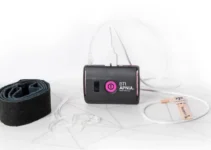Sleep apnea mouth splints, often referred to as oral appliances, are designed to assist individuals suffering from obstructive sleep apnea (OSA) by maintaining an open airway during sleep. These devices work by slightly advancing the lower jaw or by holding the tongue in a position that prevents airway blockage. With numerous types available, each tailored to fit the user’s specific dental and medical needs, these splints are becoming a popular alternative to traditional CPAP machines. Understanding how a sleep apnea mouth splint functions can provide crucial insight for those exploring non-invasive options to manage their sleep apnea symptoms effectively.
What is a Sleep Apnea Mouth Splint?
A sleep apnea mouth splint is a dental device designed to manage obstructive sleep apnea (OSA), a condition where the airway becomes blocked during sleep, leading to interrupted breathing. This non-invasive treatment option is particularly beneficial for individuals who cannot tolerate continuous positive airway pressure (CPAP) therapy. By positioning the jaw in a forward position, the splint helps maintain an open airway, improving sleep quality and overall health.
Understanding the functionality and types of sleep apnea mouth splints can help you make an informed decision if you’re considering this treatment for OSA. In the following sections, we delve into their definition, how they work, and the various types available.
Definition and Function
A sleep apnea mouth splint, also known as a mandibular advancement device (MAD), is a custom-fitted dental appliance. It fits snugly over the teeth and works by holding the lower jaw (mandible) slightly forward. This positioning helps to increase the space in the back of the throat, which in turn reduces the likelihood of airway obstruction during sleep.
Studies have shown that sleep apnea mouth splints can significantly reduce the severity of OSA symptoms. They are often recommended for patients with mild to moderate OSA, as well as those who cannot tolerate CPAP therapy. By improving airflow, these devices can lead to better sleep quality and reduced daytime sleepiness.
How It Works
When you wear a sleep apnea mouth splint, it gently repositions your lower jaw and tongue forward. This adjustment prevents the soft tissues at the back of your throat from collapsing and obstructing the airway. The device’s effectiveness lies in its ability to maintain this positioning throughout the night. The process of getting a mouth splint typically involves several steps:
- A dental examination to assess suitability.
- Taking dental impressions to ensure a custom fit.
- Fitting and adjusting the device for comfort and efficacy.
Regular follow-ups with your dentist are crucial to ensure the device remains effective and comfortable. Adjustments may be needed over time, especially if there are changes in dental structure or symptoms.
Different Types
There are various types of sleep apnea mouth splints, each with unique features to cater to different needs. The most common types include monobloc devices, which are one-piece units, and titratable devices, which allow for incremental adjustments to the jaw position.
Monobloc devices are simpler and generally more affordable, making them a good option for many patients. However, titratable devices offer greater flexibility and comfort, as they can be adjusted to find the optimal jaw position. This adjustability can lead to better compliance and effectiveness.
Additionally, there are custom-fitted devices, which are made based on dental impressions, and over-the-counter devices, which can be adjusted at home. While custom-fitted devices typically offer better performance and comfort, over-the-counter options can be a more accessible starting point for some patients.
Choosing the right type of sleep apnea mouth splint depends on several factors, including the severity of OSA, patient preference, and budget. Consulting with a dental professional can help determine the most suitable option.
If you’re interested in learning more about sleep apnea and its treatments, be sure to read our other articles on the subject. Staying informed is the first step to better health and improved sleep.
Benefits of Using a Sleep Apnea Mouth Splint
Sleep apnea is a condition characterized by repeated interruptions in breathing during sleep. These interruptions can lead to fragmented sleep and other health issues. One effective treatment for sleep apnea is the use of a mouth splint, also known as an oral appliance. This device helps to keep the airway open by repositioning the jaw and tongue. In this article, we will explore the benefits of using a sleep apnea mouth splint, focusing on improved sleep quality and reduced risk of health issues.
Improved Sleep Quality
The primary benefit of using a sleep apnea mouth splint is its ability to significantly improve sleep quality. By keeping the airway open, the device reduces the number of apnea events, allowing for more continuous and restful sleep. This results in fewer awakenings and a more stable sleep pattern. Several studies have shown that patients using mouth splints experience a notable decrease in daytime sleepiness and an overall improvement in sleep efficiency.
Additionally, better sleep quality leads to an array of positive outcomes such as improved cognitive function, enhanced mood, and greater energy levels throughout the day. These benefits can help improve overall quality of life, making everyday activities easier and more enjoyable.
Here are some specific ways in which improved sleep quality can make a difference:
- Enhanced mental clarity and focus
- Better emotional stability
- Reduced stress and anxiety levels
Reduced Risk of Health Issues
Another significant benefit of using a sleep apnea mouth splint is the reduction in the risk of associated health issues. Sleep apnea has been linked to a variety of serious health conditions, including cardiovascular diseases, diabetes, and stroke. By mitigating apnea events, the mouth splint helps to lower blood pressure and improve heart health.
Studies have shown that patients who manage their sleep apnea effectively with a mouth splint have a reduced risk of developing serious complications. For example, by improving oxygen levels and sleep quality, patients can experience better control over their blood sugar levels, reducing the risk of type 2 diabetes.
Here are some health issues that can be alleviated to some extent by using a sleep apnea mouth splint:
- Hypertension (high blood pressure)
- Cardiovascular diseases such as heart attack and stroke
- Type 2 diabetes
In summary, the use of a sleep apnea mouth splint not only improves sleep quality but also provides a protective effect against several serious health issues. If you are interested in learning more about sleep apnea treatments, be sure to read our other articles on this topic.
How to Get Started with a Sleep Apnea Mouth Splint
Sleep apnea is a serious condition that affects millions of people worldwide. One of the most effective non-invasive treatments is the use of a sleep apnea mouth splint. Also known as a mandibular advancement device (MAD), this appliance can help to keep your airway open while you sleep, reducing or even eliminating apneic episodes. Getting started with a mouth splint involves a few essential steps, including consultation, fitting, customization, and ongoing care.
The journey to better sleep begins with consulting a specialist, typically a dentist trained in sleep medicine. Once a decision is made to use a mouth splint, the next steps involve the fitting and customization of the device to ensure it fits perfectly. Finally, like any medical device, proper maintenance and care are crucial for its effectiveness and longevity.
Consultation with a Specialist
The first step in acquiring a sleep apnea mouth splint is to consult with a specialist. This might be a sleep medicine physician or a dentist with training in sleep disorders. During this consultation, the specialist will evaluate your medical history, discuss your symptoms, and possibly conduct a sleep study to determine the severity of your condition.
A comprehensive examination will help to identify whether a mandibular advancement device is suitable for you. Specialists will take into account various factors, including the severity of your sleep apnea, dental health, and jaw structure. This thorough evaluation ensures that the treatment plan is tailored specifically to your needs.
Fitting and Customization
After the initial consultation, the next phase involves the fitting and customization of the mouth splint. This process starts with taking precise measurements and impressions of your teeth and jaw. Advanced techniques such as digital scans may also be used to create an accurate model of your mouth.
Once the measurements are taken, the device is manufactured to ensure it fits snugly and comfortably. Customization is essential because a poorly fitted mouth splint can cause discomfort and may not effectively treat your sleep apnea. The customization process usually involves:
- Initial fitting to make sure the device fits properly.
- Periodic adjustments to ensure continued comfort and effectiveness.
- Follow-up appointments to monitor progress and make necessary modifications.
Maintenance and Care
Proper maintenance and care of your sleep apnea mouth splint are crucial for its longevity and effectiveness. Regular cleaning will help to prevent the buildup of bacteria and other contaminants, ensuring that the device remains hygienic. Most specialists recommend using a soft toothbrush and mild soap for daily cleaning.
Additionally, it’s essential to store the device correctly when not in use. Most mouth splints come with a protective case that helps to keep it safe from damage. Frequent check-ups with your specialist will also help to ensure the device remains in good condition and continues to provide optimal results.
By following these steps, you can maximize the benefits of your sleep apnea mouth splint and enjoy a better quality of sleep. For more information on sleep apnea and other related treatments, be sure to read our other articles.
Common Questions About Sleep Apnea Mouth Splints
If you’re exploring options for treating sleep apnea, you might have come across the term “sleep apnea mouth splint.” Here are some FAQs to help you understand how these devices work and their effectiveness.
What is a sleep apnea mouth splint and how does it work?
A sleep apnea mouth splint, also known as a mandibular advancement device, is used to treat sleep apnea by adjusting the position of the jaw and tongue during sleep. This adjustment helps to keep the airway open, reducing the episodes of paused breathing (apneas) caused by airway obstructions. It is a custom-made device fitted by a dental specialist to ensure comfort and effectiveness.
Is a sleep apnea mouth splint effective for all types of sleep apnea?
Sleep apnea mouth splints are most effective for treating mild to moderate obstructive sleep apnea. They are not typically recommended for patients with severe obstructive sleep apnea or central sleep apnea, as these conditions often require more advanced forms of treatment like CPAP (Continuous Positive Airway Pressure) therapy. It is crucial to undergo a thorough diagnostic evaluation to determine the most appropriate treatment for your specific condition.

My name is Salman Kapa, a 73-year-old expert in bone regeneration and dental implantology. With decades of experience in the field, I am dedicated to advancing our understanding of oral health and hygiene. Through my research and writing, I aim to contribute to the development of innovative solutions in dental care.




